
A cyclotron is a type of particle accelerator invented by Ernest O. Lawrence in 1929–1930 at the University of California, Berkeley, and patented in 1932. A cyclotron accelerates charged particles outwards from the center of a flat cylindrical vacuum chamber along a spiral path. The particles are held to a spiral trajectory by a static magnetic field and accelerated by a rapidly varying electric field. Lawrence was awarded the 1939 Nobel Prize in Physics for this invention.

A linear particle accelerator is a type of particle accelerator that accelerates charged subatomic particles or ions to a high speed by subjecting them to a series of oscillating electric potentials along a linear beamline. The principles for such machines were proposed by Gustav Ising in 1924, while the first machine that worked was constructed by Rolf Widerøe in 1928 at the RWTH Aachen University. Linacs have many applications: they generate X-rays and high energy electrons for medicinal purposes in radiation therapy, serve as particle injectors for higher-energy accelerators, and are used directly to achieve the highest kinetic energy for light particles for particle physics.

A synchrotron light source is a source of electromagnetic radiation (EM) usually produced by a storage ring, for scientific and technical purposes. First observed in synchrotrons, synchrotron light is now produced by storage rings and other specialized particle accelerators, typically accelerating electrons. Once the high-energy electron beam has been generated, it is directed into auxiliary components such as bending magnets and insertion devices in storage rings and free electron lasers. These supply the strong magnetic fields perpendicular to the beam which are needed to convert high energy electrons into photons.
Accelerator physics is a branch of applied physics, concerned with designing, building and operating particle accelerators. As such, it can be described as the study of motion, manipulation and observation of relativistic charged particle beams and their interaction with accelerator structures by electromagnetic fields.
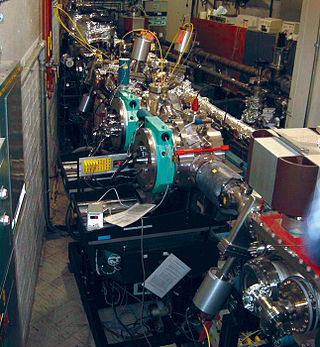
In accelerator physics, a beamline refers to the trajectory of the beam of particles, including the overall construction of the path segment along a specific path of an accelerator facility. This part is either

Quadrupole magnets, abbreviated as Q-magnets, consist of groups of four magnets laid out so that in the planar multipole expansion of the field, the dipole terms cancel and where the lowest significant terms in the field equations are quadrupole. Quadrupole magnets are useful as they create a magnetic field whose magnitude grows rapidly with the radial distance from its longitudinal axis. This is used in particle beam focusing.

A dipole magnet is the simplest type of magnet. It has two poles, one north and one south. Its magnetic field lines form simple closed loops which emerge from the north pole, re-enter at the south pole, then pass through the body of the magnet. The simplest example of a dipole magnet is a bar magnet.

A synchrotron is a particular type of cyclic particle accelerator, descended from the cyclotron, in which the accelerating particle beam travels around a fixed closed-loop path. The magnetic field which bends the particle beam into its closed path increases with time during the accelerating process, being synchronized to the increasing kinetic energy of the particles. The synchrotron is one of the first accelerator concepts to enable the construction of large-scale facilities, since bending, beam focusing and acceleration can be separated into different components. The most powerful modern particle accelerators use versions of the synchrotron design. The largest synchrotron-type accelerator, also the largest particle accelerator in the world, is the 27-kilometre-circumference (17 mi) Large Hadron Collider (LHC) near Geneva, Switzerland, built in 2008 by the European Organization for Nuclear Research (CERN). It can accelerate beams of protons to an energy of 6.5 tera electronvolts (TeV or 1012 eV).
An electrostatic lens is a device that assists in the transport of charged particles. For instance, it can guide electrons emitted from a sample to an electron analyzer, analogous to the way an optical lens assists in the transport of light in an optical instrument. Systems of electrostatic lenses can be designed in the same way as optical lenses, so electrostatic lenses easily magnify or converge the electron trajectories. An electrostatic lens can also be used to focus an ion beam, for example to make a microbeam for irradiating individual cells.
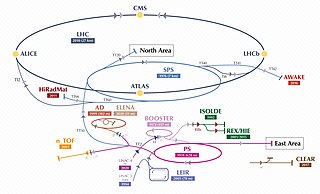
The Proton Synchrotron is a particle accelerator at CERN. It is CERN's first synchrotron, beginning its operation in 1959. For a brief period the PS was the world's highest energy particle accelerator. It has since served as a pre-accelerator for the Intersecting Storage Rings (ISR) and the Super Proton Synchrotron (SPS), and is currently part of the Large Hadron Collider (LHC) accelerator complex. In addition to protons, PS has accelerated alpha particles, oxygen and sulfur nuclei, electrons, positrons, and antiprotons.

The Advanced Light Source (ALS) is a research facility at Lawrence Berkeley National Laboratory in Berkeley, California. One of the world's brightest sources of ultraviolet and soft x-ray light, the ALS is the first "third-generation" synchrotron light source in its energy range, providing multiple extremely bright sources of intense and coherent short-wavelength light for use in scientific experiments by researchers from around the world. It is funded by the US Department of Energy (DOE) and operated by the University of California. In June 2018, Stephen Kevan became the director of the ALS.

The Mainz Microtron, abbreviated MAMI, is a microtron which provides a continuous wave, high intensity, polarized electron beam with an energy up to 1.6 GeV. MAMI is the core of an experimental facility for particle, nuclear and X-ray radiation physics at the Johannes Gutenberg University in Mainz (Germany). It is one of the largest campus-based accelerator facilities for basic research in Europe. The experiments at MAMI are performed by about 200 physicists of many countries organized in international collaborations.
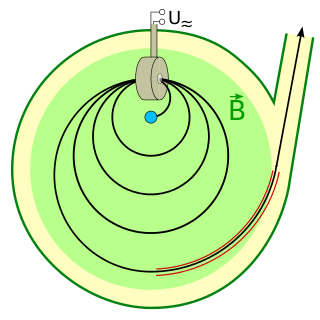
A microtron is a type of particle accelerator concept originating from the cyclotron in which the accelerating field is not applied through large D-shaped electrodes, but through a linear accelerator structure. The classic microtron was invented by Vladimir Veksler around 1944. The kinetic energy of the particles is increased by a constant amount per field change. Microtrons are designed to operate at constant field frequency and magnetic field in the ultrarelativistic limit. Thus they are especially suited for very light elementary particles, namely electrons.
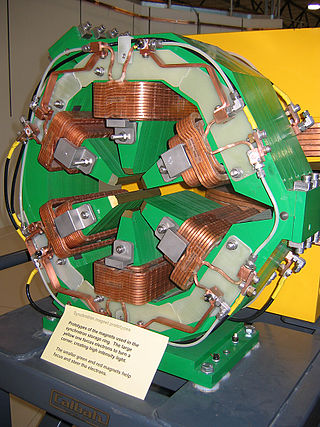
In accelerator physics strong focusing or alternating-gradient focusing is the principle that, using sets of multiple electromagnets, it is possible to make a particle beam simultaneously converge in both directions perpendicular to the direction of travel. By contrast, weak focusing is the principle that nearby circles, described by charged particles moving in a uniform magnetic field, only intersect once per revolution.
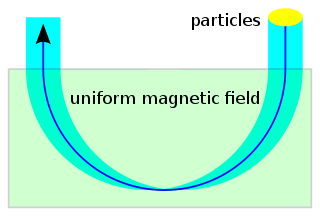
Weak focusing occurs in particle accelerators when charged particles are passing through uniform magnetic fields, causing them to move in circular paths due to the Lorentz force. Because of the circular movement, the orbits of two particles with slightly different positions may approximate or even cross each other.

A particle accelerator is a machine that uses electromagnetic fields to propel charged particles to very high speeds and energies, and to contain them in well-defined beams.

A sextupole magnet consist of six magnetic poles set out in an arrangement of alternating north and south poles arranged around an axis. They are used in particle accelerators for the control of chromatic aberrations and for damping the head tail instability. Two sets of sextupole magnets are used in transmission electron microscopes to correct for spherical aberration.

A storage ring is a type of circular particle accelerator in which a continuous or pulsed particle beam may be kept circulating typically for many hours. Storage of a particular particle depends upon the mass, momentum and usually the charge of the particle to be stored. Storage rings most commonly store electrons, positrons, or protons.
A Fixed-Field alternating gradient Accelerator is a circular particle accelerator concept that can be characterized by its time-independent magnetic fields and the use of alternating gradient strong focusing.
A charged particle accelerator is a complex machine that takes elementary charged particles and accelerates them to very high energies. Accelerator physics is a field of physics encompassing all the aspects required to design and operate the equipment and to understand the resulting dynamics of the charged particles. There are software packages associated with each such domain. There are a large number of such codes. The 1990 edition of the Los Alamos Accelerator Code Group's compendium provides summaries of more than 200 codes. Certain of those codes are still in use today although many are obsolete. Another index of existing and historical accelerator simulation codes is located at














